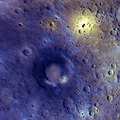
WIKIARCHIVES.SPACE
The Human Spaceflight Archive

These figures show comparisons of the neutral sodium observed during MESSENGER's second and third Mercury flybys. The left panel shows that emission from neutral sodium in Mercury's tail, which extends away from the planet in the anti-sunward direction, was a factor of 10-20 less than during the second flyby, shown in the right panel. This difference is due to variations in the pressure that solar radiation exerts on the sodium as Mercury moves in its orbit. During the third flyby, the net effect of radiation pressure was small, and the sodium atoms released from Mercury's surface were not accelerated anti-sunward as they were during the first two flybys, resulting in a diminished sodium tail. These predictable changes lead to what are effectively "seasonal" effects on the distribution of exospheric species. Observations of the sodium exosphere and tail throughout Mercury's orbit during MESSENGER's orbital mission phase will enable such "seasonal" effects to be studied.
Information
- Taken in
- Forfatter
- NASA/Johns Hopkins University Applied Physics Laboratory/Carnegie Institution of Washington
- Beskrivelse
-
These figures show comparisons of the neutral sodium observed during MESSENGER's second and third Mercury flybys. The left panel shows that emission from neutral sodium in Mercury's tail, which extends away from the planet in the anti-sunward direction, was a factor of 10-20 less than during the second flyby, shown in the right panel. This difference is due to variations in the pressure that solar radiation exerts on the sodium as Mercury moves in its orbit. During the third flyby, the net effect of radiation pressure was small, and the sodium atoms released from Mercury's surface were not accelerated anti-sunward as they were during the first two flybys, resulting in a diminished sodium tail. These predictable changes lead to what are effectively "seasonal" effects on the distribution of exospheric species. Observations of the sodium exosphere and tail throughout Mercury's orbit during MESSENGER's orbital mission phase will enable such "seasonal" effects to be studied.
Date Acquired: October 6, 2008, and September 29, 2009
Instrument: Mercury Atmospheric and Surface Composition Spectrometer (MASCS)
- Opprettet den
- Tirsdag 3 November 2009
- Albumer
- US SPACE PROGRAM / PROBES / MERCURY / MESSENGER / Annoted/Science
- Source link
- https://photojournal.jpl.nasa.gov
- Besøk
- 20
- Vurdering poengsum
- ingen vurdering
- Vurder dette bildet
- License
- Public Domain
- Modified by WikiArchives
- No (original)
- Nedlastinger
- 0
Drevet av Piwigo



